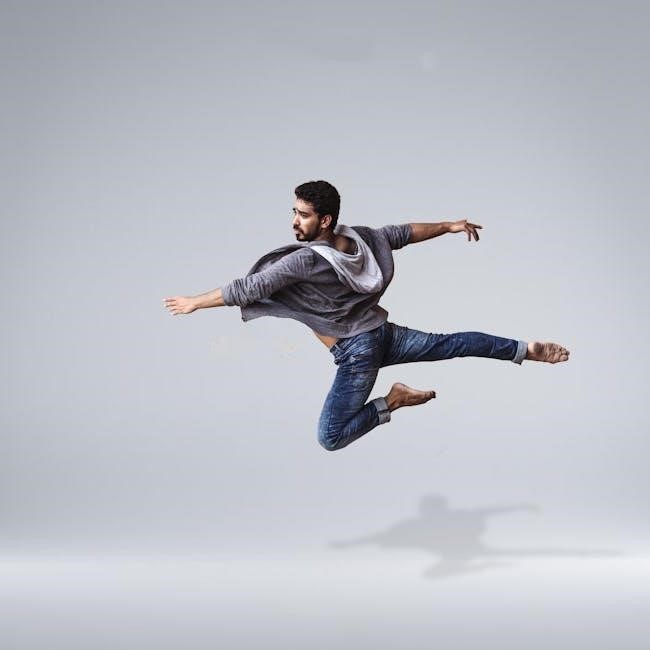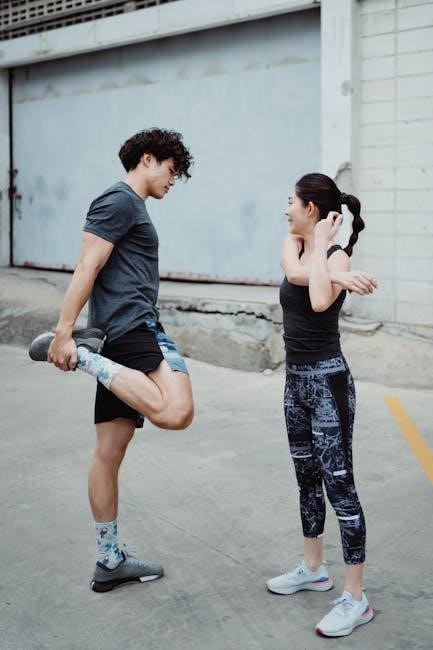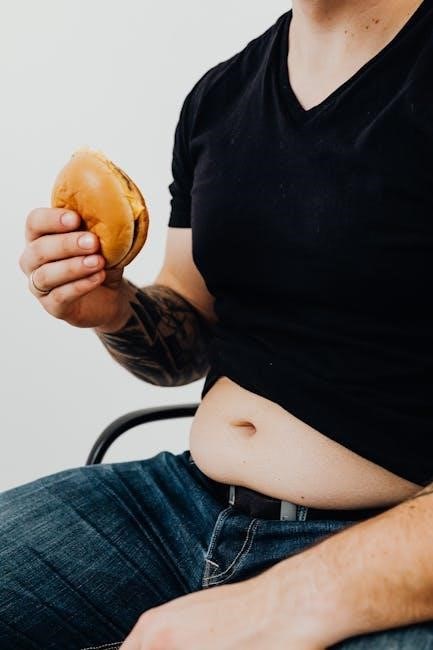
mens jeans fit guide
A well-fitting pair of jeans enhances both style and comfort. This guide covers key factors like waist, thigh, and inseam measurements to help you find the perfect fit.
1.1 Understanding the Importance of Proper Fit
A proper fit in men’s jeans is essential for both style and comfort. Ill-fitting jeans can restrict movement, cause discomfort, or appear unflattering. A well-fitted pair enhances your physique, boosts confidence, and ensures versatility in styling. Whether slim, straight, or relaxed, the right fit adapts to your body type and lifestyle, making jeans a wardrobe staple. Proper fit also extends the lifespan of your jeans, preventing excessive wear and tear. Investing time in finding the perfect fit ensures a balance between aesthetics and practicality, making every pair a worthwhile investment.
1.2 How Jeans Fit Affects Your Style and Comfort
The fit of your jeans significantly impacts both your style and comfort. A well-fitted pair enhances your silhouette, making you appear more put-together, while poor fit can detract from your look. Tight jeans may restrict movement, causing discomfort, while overly loose jeans can look sloppy. Proper fit ensures freedom of movement and a polished appearance. Higher rises can elongate your torso, and stretch denim offers flexibility. Balancing style and comfort ensures your jeans are both fashionable and functional, making them a versatile staple in your wardrobe.

Key Measurements for Men’s Jeans Fit
Waist, inseam, thigh, and seat measurements are crucial for ensuring a perfect fit, balancing comfort and style while addressing specific body types and personal preferences effectively.
2.1 Waist Measurement: How to Measure Correctly
To measure your waist accurately, place the tape measure around the narrowest part of your natural waistline, typically just above the hipbone. Ensure the tape is level and not twisted for an accurate reading. It’s best to have someone assist you to guarantee precision. Your waist measurement is critical as it determines how well your jeans will sit and fit. A proper fit should feel comfortable, neither too tight nor too loose, allowing for a full range of motion while maintaining a flattering silhouette.
2.2 Inseam: Understanding Your Leg Length
Your inseam is the measurement from the top of your inner thigh to the bottom of your ankle. To measure it, stand upright and place the tape measure along your leg, ensuring it’s straight and not twisted. This measurement determines the length of your jeans, ensuring they break correctly above your shoes. A proper inseam length avoids jeans that are too short or overly long, providing a balanced look. Accurate inseam measurement is essential for a polished, tailored appearance, regardless of your body type or preferred style.
2.3 Thigh Measurement: Ensuring a Comfortable Fit
Measuring your thigh ensures a comfortable fit, avoiding tightness or excessive looseness. Stand upright and wrap a tape measure around the widest part of your thigh, just below the crotch. The jeans should fit snugly but not restrict movement. If the fabric feels tight, it may lead to discomfort or visible strain. Proper thigh fit balances style and comfort, allowing for a natural range of motion. This measurement is especially important for athletic or muscular builds, ensuring the jeans drape smoothly without pulling at the seams.
2.4 Seat Measurement: The Right Balance for All Body Types
The seat measurement ensures the jeans fit comfortably across the buttocks. It should neither be too tight, causing discomfort, nor too loose, leading to an unflattering appearance. For smaller frames, a slightly narrower seat provides a tailored look, while larger builds benefit from a more spacious design. The seat should align with the natural curve of your body, offering support without restriction. Proper seat fit enhances both comfort and style, making it a crucial factor in selecting the ideal pair of jeans for any body type or lifestyle.

Jeans Fit for Different Body Types
Understanding your body type is key to finding the perfect jeans fit. Slim, athletic, average, and larger builds each require specific styles for optimal comfort and style.
3.1 Slim Body Type: Finding the Perfect Fit
For slim body types, slim or skinny fit jeans are ideal as they hug the legs without excess fabric. High-rise options can create a balanced, proportionate look. Ensure the thighs fit comfortably, avoiding tightness that restricts movement. Opt for stretch denim for added flexibility and comfort. Avoid overly loose styles that may overwhelm your frame. Pair with tailored tops to enhance your silhouette. The perfect fit should feel natural, complementing your body without sacrificing style or comfort.
3.2 Athletic Build: Jeans That Flatter Broad Shoulders and Thighs
For men with an athletic build, jeans should accommodate broad shoulders and thighs while maintaining a flattering fit. Opt for tapered or straight-leg styles, as they provide room in the thigh area without excessive bagginess. Stretch denim is highly recommended for its flexibility and comfort. Avoid slim-fit jeans, as they may feel restrictive. Medium or high-rise options can balance proportions, ensuring the jeans sit comfortably above the hips. Tailored fits that taper slightly from the knee create a streamlined look, enhancing the muscular physique. This ensures both style and comfort for active lifestyles.
3.3 Average Body Type: Classic and Versatile Options
For men with an average body type, classic straight-leg or medium-rise jeans are ideal. These styles offer a balanced fit, neither too tight nor too loose, and suit most body proportions. Opt for a straight-leg cut to maintain a clean, timeless look. Ensure the jeans fit comfortably around the thigh and seat, avoiding excess fabric. Medium-weight denim provides durability and a sharp appearance. Pair with fitted shirts for a polished look or loose tops for casual outings. This versatile approach ensures a flattering and practical wardrobe staple for everyday wear.
3.4 Larger Body Type: Comfort and Style for Every Size
For larger body types, comfort and style go hand in hand. Opt for relaxed or tapered fits that provide ample room in the thighs and seat without sacrificing structure. High-rise jeans can offer better support and create a more balanced silhouette. Look for stretch denim for added flexibility and a snug fit. Ensure the waistband sits comfortably to avoid discomfort. Pair with tailored tops to enhance your look. Proper fit ensures confidence and style, making jeans a versatile and essential part of your wardrobe.

Types of Jeans Fits for Men
Exploring different fits—slim, straight, relaxed, and tapered—helps men find styles that flatter their body type, ensuring comfort and a modern, tailored look for every occasion.
4.1 Slim Fit Jeans: Modern and Tailored
Slim fit jeans offer a contemporary, streamlined look, ideal for men seeking a modern aesthetic. They hug the legs without being overly tight, creating a polished appearance. Designed for those with lean or athletic builds, these jeans provide comfort while maintaining style. Pair them with fitted tops for a cohesive look or layer with jackets for versatility. Slim fit jeans are perfect for dressing up or casual outings, making them a versatile addition to any wardrobe.
4.2 Straight Fit Jeans: Classic and Versatile
Straight fit jeans are a timeless choice, offering a balanced and classic silhouette. They feature a consistent width from thigh to hem, creating a clean, straightforward look. These jeans are ideal for all body types, as they neither hug too tightly nor feel overly loose. Perfect for both casual and slightly dressy occasions, straight fit jeans pair effortlessly with a variety of tops and shoes. Their versatility makes them a wardrobe staple, suitable for everyday wear while maintaining a polished appearance.
4.3 Relaxed Fit Jeans: Roomy and Comfortable
Relaxed fit jeans offer a spacious and comfortable design, perfect for those who prioritize ease. With a looser cut through the thigh, seat, and leg, they provide maximum mobility and a casual look. Ideal for everyday wear, these jeans are great for layering or relaxed outings. Their roomy fit makes them suitable for various body types, especially those seeking comfort without compromising style. Relaxed fit jeans are a practical choice for anyone looking to balance comfort and versatility in their wardrobe.
4.4 Tapered Fit Jeans: Combining Style and Comfort
Tapered fit jeans blend style and comfort, featuring a semi-slim design that tapers from thigh to ankle. This cut creates a modern, streamlined look while maintaining comfort. Perfect for those who want a fashionable yet relaxed fit, tapered jeans suit various body types and occasions. They pair well with casual and dressy outfits, offering versatility. The tapered leg also complements different shoe styles, enhancing overall appeal. This balance makes them a versatile addition to any wardrobe, ideal for men seeking both style and ease.

Rise Types in Men’s Jeans
Jeans come in low, medium, and high rises, each offering unique style and comfort. The right rise enhances aesthetics and ensures a flattering fit for all body types.
5.1 Low Rise Jeans: Stylish but Less Supportive
Low rise jeans sit below the natural waistline, offering a modern, stylish look. They are ideal for fashion-forward individuals but may lack the support of higher rises. The lower waistband can cause discomfort for some, as it doesn’t provide the same structure as medium or high-rise options. While they are trendy, they may not be the best choice for those prioritizing comfort or needing additional support. Pairing them with a belt can help customize the fit, but they are generally less practical for everyday wear compared to other rise types.
5.2 Medium Rise Jeans: The Perfect Balance
Medium rise jeans strike a balance between style and comfort, sitting just below the belly button. This rise offers a classic look while providing sufficient support and coverage. It flatters most body types, making it a versatile choice for everyday wear. The medium rise is ideal for those who want a timeless style without sacrificing modern appeal. It works well for both casual and slightly dressy occasions, offering flexibility in pairing with various shirts and shoes. This rise is particularly popular for its ability to blend seamlessly into different wardrobes and personal styles.
5.3 High Rise Jeans: Timeless and Flattering
High rise jeans offer a classic, timeless look and are known for their flattering fit. Sitting higher on the waist, they provide excellent support and coverage, making them ideal for those who value comfort and structure. This style is particularly flattering for taller men or those with longer torsos, as it elongates the legs and creates a balanced silhouette. High rise jeans also pair well with belts and can be dressed up or down, making them versatile for both formal and casual settings. Their durability and style ensure they remain a wardrobe staple for many men.

Fabric and Denim Weight
Fabric and denim weight play a crucial role in comfort and durability. Stretch denim offers flexibility, heavyweight denim provides structure, and lightweight denim is ideal for warmer weather.
6.1 Stretch Denim: Flexibility and Comfort
Stretch denim combines traditional denim with elastane or spandex, offering unparalleled flexibility and comfort. This fabric allows for a full range of motion, making it ideal for active lifestyles or athletic builds. Unlike rigid denim, stretch denim moves with your body, reducing discomfort during daily activities. It also provides excellent recovery, maintaining its shape even after repeated wear. The four-way stretch ensures flexibility in all directions, while the soft texture enhances overall comfort. Perfect for modern, tailored fits, stretch denim balances style and practicality, making it a versatile choice for everyday wear or casual outings.
- Provides flexibility and comfort.
- Ideal for active lifestyles.
- Soft texture with excellent recovery.
- Perfect for modern, tailored fits.
6.2 Heavyweight Denim: Durability and Structure
Heavyweight denim, typically made from 12 oz or higher fabric, offers exceptional durability and structure. It is ideal for those seeking long-lasting jeans that maintain their shape. The denser weave provides a rigid feel, resisting stretch and sagging, while its thickness ensures resilience against wear and tear. Perfect for a classic, robust look, heavyweight denim is great for colder climates and pairs well with chunky boots for a rugged aesthetic. Its sturdy construction makes it a timeless choice for men who value both durability and timeless style.
- Durable and long-lasting fabric.
- Provides excellent structure and rigidity.
- Resistant to stretch and sagging.
- Perfect for colder weather and rugged outfits.
6.3 Lightweight Denim: Perfect for Warm Weather
Lightweight denim, typically made from fabric under 10 oz, is designed for comfort in warmer climates. Its breathable and soft texture keeps you cool, making it ideal for summer. While it offers less structure, it drapes elegantly, creating a relaxed fit. Lightweight jeans are versatile, pairing well with casual tops and sneakers. However, they may lack durability compared to heavier options. Perfect for seasonal wear, lightweight denim ensures comfort without compromising style, making it a must-have for warm weather wardrobes.
- Breathable and soft fabric for summer.
- Relaxed fit with a lightweight feel.
- Perfect for pairing with casual outfits.
- Less durable than heavier denim.

Troubleshooting Common Fit Issues
Addressing fit problems like tight thighs or loose waistbands can enhance comfort and style. Tailoring adjustments often resolve these issues effectively, ensuring a perfect fit.
7.1 Jeans That Are Too Tight in the Thighs
Tightness in the thighs can cause discomfort and restrict movement. This issue often arises from improper sizing or a denim fabric with limited stretch. To resolve this, consider opting for stretch denim or a slightly larger size. If altering, a tailor can adjust the thigh area for a more comfortable fit. Ensuring the thighs aren’t too tight ensures both style and practicality, making your jeans wearable for extended periods without discomfort or unsightly pulling at the seams.
7.2 Jeans That Are Too Loose in the Waist
Jeans that are too loose in the waist can look unflattering and cause discomfort. This issue often results from sizing up too much or a poor fit. To address this, consider sizing down or opting for a higher rise style, which provides better support. Tailoring can also help—adjusting the waistband or adding darts can create a more tailored fit. Ensuring the waist fits snugly without excessive gaping ensures a polished look and prevents the need for frequent adjustments. A well-fitted waist enhances both style and comfort, making your jeans more wearable and versatile for any occasion.
7.3 Jeans That Are Too Short or Too Long
Jeans that are too short may leave your ankles exposed, while those too long can bunch awkwardly around the shoes. To fix this, ensure your inseam matches your leg length. Tailoring is a great solution—hemming too-long jeans or letting out hems if possible. Some styles, like cropped or stacked looks, intentionally deviate from standard lengths. If altering isn’t an option, try pairing overly long jeans with boots or cuffing them for a stylish touch. Proper length enhances both aesthetics and functionality, ensuring your jeans look polished and feel comfortable all day.

The Role of Tailoring in Jeans Fit
Tailoring ensures a precise fit, addressing issues like waist gaps or uneven hems. Custom adjustments enhance comfort and style, making even off-the-rack jeans feel personalized and polished.
8.1 When to Consider Custom-Made Jeans
Custom-made jeans are ideal for those who struggle with off-the-rack fits or have unique body types. They offer tailored measurements, ensuring a flawless fit from waist to hem. If you’ve tried multiple brands without success or desire a specific style, custom jeans are worth considering. They provide durability and a personalized touch, making them a worthwhile investment for long-term comfort and style.
8.2 How Tailoring Can Improve the Fit of Off-the-Rack Jeans
Tailoring can transform off-the-rack jeans into a custom-like fit. Adjustments like shortening the inseam or taking in the waist ensure a more flattering silhouette. For those with larger thighs, darts or letting out seams can provide comfort without sacrificing style. Even minor tweaks, like resizing the waistband or tapering legs, make a significant difference. Tailoring is a cost-effective way to enhance both the look and comfort of store-bought jeans, making them feel uniquely tailored to your body.
Styling Tips Based on Jeans Fit
Pair slim-fit jeans with fitted tops for a modern look, while loose fits can be balanced with tailored jackets for a polished appearance.
9.1 How to Pair Shoes with Your Jeans Fit
Pairing shoes with your jeans fit can elevate your style. For slim-fit jeans, opt for sleek, low-top sneakers or loafers to maintain a streamlined look. Straight-leg jeans pair well with boots or dress shoes, adding versatility. Relaxed-fit jeans can be matched with casual sneakers or sandals for a laid-back vibe. Tapered jeans work best with elegant derbies or monk straps for a polished appearance. Consider the rise of your jeans too—higher rises can be worn with loafers, while lower rises suit sneakers. Balance proportions to create a cohesive outfit.
9.2 Matching Shirts and Tops to Your Jeans Fit
Matching shirts to your jeans fit enhances your overall style. Slim-fit jeans pair perfectly with fitted or slim-cut shirts for a modern look. Straight-leg jeans work well with classic button-downs or casual graphic tees. Relaxed-fit jeans can be paired with loose-fitting tops for comfort. Tapered jeans complement tailored shirts or polo tees for a polished appearance. Consider the rise of your jeans too—higher rises can be paired with tucked-in shirts or longer tops, while lower rises suit shorter, untucked styles. Layering with jackets or sweaters can also add versatility to your outfit.

Maintenance and Care for Well-Fitting Jeans
Proper care extends the life of your jeans; Wash inside out in cold water, avoid hot drying, and use mild detergents to preserve fit and color.
10.1 Washing and Drying Tips for Preserving Fit
To maintain the perfect fit, wash your jeans inside out in cold water using a mild detergent. Avoid hot water, as it can cause shrinkage. Steer clear of bleach or harsh chemicals, as they can weaken the fabric. Gently agitate the water by hand or use a delicate cycle. After washing, reshape the jeans while damp and air-dry them away from direct sunlight. Never put jeans in a hot dryer, as heat can alter the fit and fade the color. Proper care ensures your jeans remain comfortable and stylish for years.
10.2 How to Prevent Stretching or Shrinking
To prevent stretching, avoid excessive wear without washing, as this can loosen the fabric. Break in jeans gradually to maintain shape. For shrinking, skip hot water and dryers, as heat causes contraction. Air-dry jeans or use a steamer instead of ironing. Turn jeans inside out to minimize pilling and prevent friction. Use a denim-specific detergent to preserve fibers. For stretch denim, avoid over-stretching during wear. Mend small tears promptly to prevent further damage. Store jeans folded or hanging to maintain their form and avoid creases that can weaken fabric over time.
A perfect fit enhances confidence and style, making it worth the effort to find or tailor jeans that suit your body perfectly.
11.1 Final Thoughts on Achieving the Perfect Fit
Achieving the perfect fit in men’s jeans is transformative, boosting confidence and style. It requires understanding your body type, measuring accurately, and considering fabric and rise. Tailoring can refine off-the-rack options, while custom-made jeans offer precision. Experiment with styles to find what flatters you most. Proper care ensures longevity, preserving the fit over time. Remember, great-fitting jeans are an investment in both comfort and self-expression, making the effort worthwhile to find your ideal pair.
11.2 Encouragement to Experiment and Find Your Style
Experimenting with different fits and styles is key to discovering your personal aesthetic. Don’t be afraid to try new looks—confidence and comfort are the ultimate style markers. Embrace your unique body type and explore how various rises, fabrics, and inseams enhance your appearance. Pair your jeans with shoes, shirts, and accessories that reflect your personality. Remember, fashion is a journey, and it’s okay to evolve. Take care of your jeans to maintain their fit, and enjoy the process of crafting a wardrobe that truly represents who you are.

Frequently Asked Questions
Addressing common concerns, this section answers questions like how to fix tight jeans, prevent stretching, and determine if alterations are needed for a perfect fit.
12.1 What’s the Difference Between Slim and Skinny Jeans?
Slim jeans offer a tailored fit with a slightly tapered leg, while skinny jeans are tighter and cling closer to the skin. Slim jeans are versatile, suitable for most body types, and pair well with casual or dressy outfits. Skinny jeans, however, provide a bold, fashion-forward look, ideal for those who prefer a modern, edgy style. Both styles emphasize comfort and flexibility, with slim jeans offering more room and skinny jeans hugging the legs tightly. Understanding these differences helps men choose the right fit for their personal style and preferences.
12.2 Can I Alter My Jeans for a Better Fit?
Yes, altering jeans can significantly improve the fit. Common alterations include shortening the inseam for the perfect length, taking in the waist for a snugger fit, or adjusting the thigh area for comfort. Tailors can also taper the legs for a slimmer look or let out seams for more room. DIY adjustments are possible for minor tweaks, but professional tailoring ensures precise results. Alterations allow you to customize off-the-rack jeans to your body, enhancing both style and comfort without compromising on quality or durability.
12.3 How Do I Know If My Jeans Are Too Tight?
Your jeans are too tight if they restrict movement, cause discomfort, or leave marks on your skin. Check if the waistband feels constricting or digs into your stomach. If the fabric pulls at the seams, especially around the thighs or crotch, it indicates a tight fit. Additionally, if sitting down feels uncomfortable or causes awkward stretching in the crotch area, your jeans may be too tight. Jeans should fit snugly but allow a full range of motion without causing strain or numbness. Prioritize comfort and ensure your jeans drape naturally on your body.
Leave a Reply
You must be logged in to post a comment.